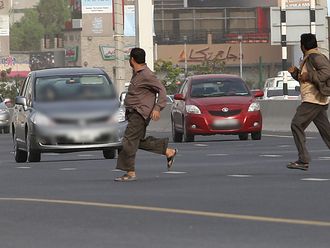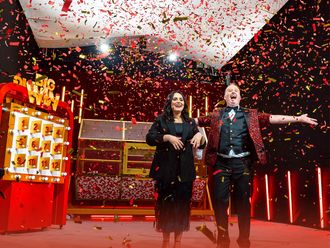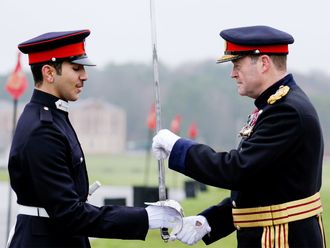
If you were born after 1960, the odds that you will get cancer in your lifetime are now one in two. It is an extraordinary statistic. Even if you turn out to be one of the lucky ones, half of the people around your kitchen table this morning will at some point sit in a doctor’s surgery and be given the news that they have cancer. If the numbers continue in the same relentless direction, before long, it will be most of them.
Not all will have chemotherapy. The fortunate ones can be cured in other ways, while the truly unfortunate will have cancers chemo cannot treat. I met one of those unluckiest of souls only the other day. It hadn’t occurred to me until then to feel very grateful for having been eligible for what was, without a doubt, the most unpleasant medical ordeal of my life.
“Unpleasant” is a word you hear a lot when people talk about chemo. It drove me to distraction when I was first diagnosed with breast cancer last summer, and was told I would undergo four months of chemotherapy. Like everyone else plunged into this frightening new world, I wanted to know what would happen. What would it be like?
“Well, it’s doable,” I read time and again, as I scanned online cancer forums for answers. “Unpleasant — but doable.” It was maddening. Waiting to begin chemo is like being on medical death row; you know your body is about be attacked, but how it will feel is a sinister mystery, and unknowable dread only makes the waiting worse.
There is a reason for this inarticulacy. Human beings have had no historical need to evolve language applicable to the sensation of being systematically poisoned. Such a vocabulary has never before been necessary, so it does not exist. Chemotherapy patients are therefore obliged to deploy a limited repertoire of familiar but hopelessly inadequate substitutes; words that can only approximate to the experience, but fail to convey anything of its true essence. So we say that we are tired, and feel weak; that we have no energy, or feel somehow unrecognisably unlike ourselves. What we really mean — and this doesn’t capture it either, but it’s the best I can do — is that we feel dead without having actually died. Chemotherapy strips away every last ounce of vitality or volition, until you are left only with the outward appearance of a living person. But you are a hollow husk, empty of all the essential constituents that make a person alive. It is a cruel irony that a drug designed to stop you dying makes you feel as if you have.
One of the many side-effects of chemotherapy of which I’d been hitherto unaware is what it does to your brain. The medical profession was reluctant for many years to acknowledge a condition oncologists now call, with inelegant if commendable candour, “chemo brain” — and like every other side-effect, it does not afflict everyone. But having witnessed the steady erosion of my own critical faculties, to the point where my IQ had sunk to marginally lower than my cat’s, I can testify that chemo makes some patients very, very stupid.
It is partly because of that that I hesitated to write this. A cancer diagnosis pitches you into a disorientating fog of confusing, alarming and often contradictory advice, which would be hard enough to navigate at the best of times. Trying to work out what’s loopy and what might save your life — or at least your sanity — when you can’t even follow the Jeremy Kyle Show can be profoundly frightening. Everyone is, of course, only trying to help, but when the stakes are so high and you can’t think straight, the cacophony of advice is often counter-productive. I am reluctant to add to it.
Nevertheless, it is also the case that before I began chemotherapy I stumbled, quite by chance, upon two pieces of advice so invaluable that without them I do not like to think how I would have got through it. What is mystifying is why neither featured in a single NHS leaflet or cancer website I read. One is not cheap, and the other not easy, but both were more than worth it. I picked up some other tips along the way, which also feel worth sharing. So when anyone now asks me what advice I would offer to someone preparing for chemo, this is what I say.
Fake hair, real help
When I was first told I would have chemo, all I could think about was my hair. I would be having a double mastectomy, but losing my breasts didn’t frighten me anything like as much as losing my hair. I remember feeling embarrassed and surprised by my sense of priorities. But you do not need to spend long in oncology waiting rooms to discover that the chief preoccupation of many, if not most, patients is the horror of going bald.
Some varieties of chemo don’t make your hair fall out. Unfortunately, the kind I needed did. There are patients who manage to retain some hair by wearing a helmet of ice called a cold cap during every infusion — but this is excruciatingly arduous, often doesn’t work, and even when it does, will probably leave you with patchy wisps. I briefly considered the headscarf/turban alternative, but the futility of the artifice felt tragic. You might as well stick a sign on your head that says: LOOK! I’VE GOT CANCER. A wig therefore seemed the only tenable solution — but even the most ingeniously convincing one would still have to come off every night. I did not want to have to see myself bald — and I wouldn’t be the only one that had to. My sons were only five and four, and I knew they would hate it.
When an oncology nurse handed me a leaflet for Jennifer Effie’s Hair Solutions, offering an option I had never heard of, I thought it sounded too good to be true. (Other providers, I should say, are available.) If it really existed, how come no one else had mentioned it? The leaflet claimed I could have replacement hair glued to my head, which I would sleep in, wash and blow dry as normal, even wear in a pony tail, exactly as if it were my own. I read it doubtfully, in the waiting room of a private clinic. I was only there for a one-off consultation in search of a second opinion, and suspected this magical fake hair was probably a Harley Street racket to rip off the gullible rich.
But I couldn’t help wondering — what if it actually worked? Two days later I went to see Jennifer. A warm, smiley south Londoner, she seemed more like a therapist or nurse than a Mayfair hair stylist, and certainly nothing like a con artist. She had made it her life’s work to help women who had lost their hair, she said, by providing “not wigs, they are not wigs. They are hair-replacement systems.” For Jennifer it didn’t sound like a business so much as a vocation, and the intent tenderness of her compassion quite disarmed me. She took three separate strands from my head, which would be sent to Russia, where human hair matching the different shades of blonde would be purchased. Then she wrapped Sellotape around my head to make a mould for a lace cap, on to which each individual strand would be hand stitched. The roots would then be coloured darker to make the hair look highlighted, like mine. As soon as my own hair began to fall out, I was to come in, and Jennifer would shave it off and glue on the hair replacement system using a special adhesive. My own hairdresser would cut and style it as normal, and no one would ever guess it wasn’t mine.
The curious thing about losing one’s hair is that even though you know it is going to fall out, the first clump to come away in your hand is a horrifying shock. I stared at it, in disbelief, and wept. To be so stunned made no sense at all, but is, I have subsequently learned, what almost everyone feels. I got on the train that afternoon, and went to see Jennifer to have my system applied.
To care so much about one’s hair when you have cancer might seem like vanity, but really it is just a longing for normality. And the hair-replacement system made me normal. Jennifer was right — no one could tell. After a month or so I told my children it wasn’t my hair, and they were incredulous. A close friend I saw most days had no idea for months, until I happened to mention it. My oncologist even congratulated me for braving the cold cap, and marvelled at its success until I explained. The only difference between my hair and the system was that the “fake hair”, as my sons called it, looked considerably better.
It had to be removed and washed every three or four weeks, and occasionally repaired with replacement strands. These visits to Jennifer were — if this is not too peculiar a word in such a context — the highlight of my chemotherapy experience. The Macmillan Cancer Centre at University College Hospital in London, where I was treated, is an NHS flagship of oncology, and all the staff there work heroically and tirelessly. But they do so under impossibly overstretched conditions that make the kind of emotional support they long to give out of the question. I found it in Jennifer’s salon instead.
The system cost around £1,600 (about Dh8,528), which will be prohibitively expensive for some. I wish everyone could get it: it bought me something I couldn’t put a price on. I always made sure to face the salon wall, never the mirror, while Jennifer removed and worked on the system. I must therefore be one of the few chemotherapy patients to have lost all her hair and never once seen herself bald. That is a mercy for which I will be eternally grateful.
I discovered how it would feel to have others see me when I had the system removed before I underwent surgery. All week in hospital, I took care not to look in a mirror. But as soon as I stepped on to the street wearing a cancer bandana, strangers registered my baldness beneath it and stared with faintly repulsed pity, or quickly edged away. It was rush hour on the train home, and standing room only, but no one took the empty seat beside me. The relief to have the system re-applied after a week was indescribable.
Fasting to feel better
After nine months of cancer treatment, I still have not met one patient or medic who had heard of a hair-replacement system. Why my second piece of advice is not common knowledge either seems, if anything, even more surprising. I would never have come across it had a good friend not suffered from a chronic auto-immune condition, which the NHS treated with a drug for 20 years before deciding it could no longer afford it. An urgent search for alternative treatment strategies led my friend to an American-based Italian professor of gerontology called Dr Valter Longo, who specialises in the medical benefits of fasting. Astonished by his findings, she began to experiment with fasting for herself, and very soon felt better than she had for 20 years. Had I not witnessed this with my own eyes, I might not have paid attention when she told me to read Longo’s research into the benefits of fasting for chemotherapy patients.
The findings were certainly arresting. They fall into two categories. His early studies conducted on mice found that periods of severe fasting significantly increased the efficacy of chemotherapy. For example, among mice with a highly aggressive type of cancer, 20 per cent of those in which the cancer had fully spread, and 40 per cent with a more limited spread, were completely cured after fasting in conjunction with chemotherapy. In neither case did a single mouse treated with chemotherapy alone survive.
Further studies are ongoing, and human trials are under way. As I am completely unqualified to take a view, it would be absurd of me to wade into the scientific debate. But if I can’t give a clinical recommendation, I can at least report my own experience regarding Longo’s second claim. His trials on humans found that fasting dramatically reduced the side effects of chemotherapy. Starvation conditions, I read, protected the body’s normal cells — but not cancer cells — from the toxicity. Again, further trials are under way in the US, but when I consulted oncologists at UCH, only one had heard about it. “The evidence does look very interesting,” she agreed. “Until we can be sure it actually works, though, I don’t want to tell patients to starve themselves on top of everything else they’re having to endure. But if you want to give it a go, go ahead.”
The process Longo recommended sounded daunting, but fairly straightforward; you eat nothing for 72 hours prior to chemo, and for 24 hours afterwards. It doesn’t have to be quite that brutal; small quantities of miso soup or steamed green vegetables are permissible. But I suspected that being tantalised by morsels of sustenance might make it harder, so opted for the nothing-but-water approach. I decided to try the first round of chemo without fasting, to find out how bad it would be, and then follow his advice for the second to see if it made any difference. If the whole business turned out to be utter quackery, at worst, all it meant was that I would have spent a few days feeling pointlessly hungry.
Had round one turned out not to be too bad, I probably wouldn’t have tried fasting for the second. And for 24 hours following the first infusion, I wondered what all the fuss was about. If anything, I felt a bit of a fraud. There I was in the spare room of a friend, who had packed her family off for the weekend in order to look after me, and I was in no worse shape than she was. On day two, I suggested she might as well go to the gym, while I went for a walk.
It’s a good job I followed a bus route. Twenty minutes later I hobbled back on a No 9, and it was a week before I emerged from her spare room to face the world again. What began as a recognisable sensation, like a very bad hangover, soon had me staring lifelessly at the ceiling, slack-jawed and vegetative, wondering how I would ever make it to the bathroom, which was less than six feet from the bed. This made the decision to try eating nothing for 96 hours the next time very easy.
People who fast regularly always say it gets easier after the first 24 hours. I’d always assumed they were lying, but it turns out to be true. By the afternoon of day two I began to feel slightly light-headed, but was no longer hungry. The much-fabled starvation high kicked in on day three, and although by day four I was getting excited about the prospect of eating again, if I’d had to go another day I would have felt surprisingly sanguine.
By then I was back in my friend’s spare room, braced for the toxic onslaught. I had come prepared with audio books this time, and went to bed that night assuming it would be days before I left the house again. I waited. And waited. And nothing happened. It was like lying down on the tracks for a train that never came. Eventually I got up, went out shopping, bought some trainers, and caught the train home.
What fasting could not do was spare me the cumulative devastation of chemo. Week by week, as the cycles wore on, I found myself sinking helplessly into a torpor of inertia. Each round stole more of my soul, until by the end — and for months afterwards — all I could do was watch Jeremy Kyle. But to have been spared the toxic intensity of the immediate aftermath of each round was miraculous, and going without food a tiny price to pay for such an astonishing dividend. I wasn’t even tempted to eat. Friends assumed it must have been hellishly hard to live on water for four days, but nothing could have induced me to break each fast. To feel merely dead, as opposed to hideously ill and dead, felt like a lottery win.
Horsepower and tattoos
When chemotherapy ends, it takes at least a month before most patients even begin to feel better, and many more before you feel anything like your old self. There are, however, things you can do to hurry up the return of your old appearance.
Hair usually begins to grow back after about six weeks, but the process is painfully slow. If you want to accelerate it, my advice would be to ignore the ruinously expensive shampoos a Google search will recommend, and buy a brand called Mane’n’Tail . As the name suggests, it is actually designed for horses, but it is perfectly safe for human use, and the only product I have found that dramatically increases the pace and quality of regrowth.
For some reason, eyelashes and eyebrows grow back even more slowly. The eyebrow problem can be solved by taking pre-emptive action before they fall out, and having them tattooed. The process is surprisingly painless, and remarkably convincing; like the hair-replacement system, tattooed eyebrows were a happy improvement on my own. One important word of advice: do not wait until yours have fallen out before having them done. The tattooist won’t know where your eyebrows normally lie, so you run the risk of ending up with two sets when yours grow back.
To speed up the return of eyelashes, the only product I would recommend is something called Revitalash, which you paint on to the rims of your eyelids once a day, and works. When your eyelashes are a few millimetres long, it is tempting to consider having semi-permanent extensions applied, but this is a bad idea. When they fall out they are in danger of taking your own with them, leaving you back to square one. A safer option are fibre eyelash extensions, made by a company called Cherry Blooms. The application process is just like mascara, if a trifle fiddlier, takes only two minutes, and transforms stumps into normal-looking lashes.
To any reader lucky enough to have never had cancer, none of this advice may sound terribly important. It was only when I got cancer myself that I realised how little I had understood of what friends who’d had chemo had been through. When it isn’t your own body that has to endure the agonies and indignities, all that really seems to matter is keeping it alive. When it is your own body, you discover how much more there is to care about.
— Guardian News & Media Ltd, 2016












